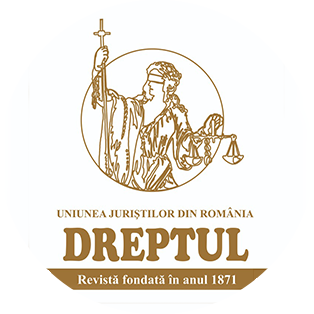-
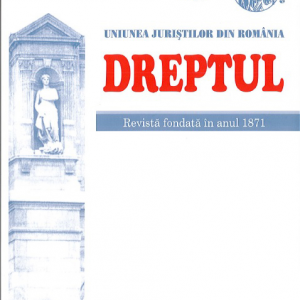 Unpaid community work has received multiple valences in the Romanian criminal law system, representing either an obligation in the content of the probation measures or a way of executing the penalty of the fine or an obligation that accompanies the abandonment of the criminal prosecution. The complexity of the institution, together with its novelty, has generated a series of difficulties including in respect of the performance of the unpaid community work, this article emphasizing some of these difficulties and proposing solutions for their removal.
Unpaid community work has received multiple valences in the Romanian criminal law system, representing either an obligation in the content of the probation measures or a way of executing the penalty of the fine or an obligation that accompanies the abandonment of the criminal prosecution. The complexity of the institution, together with its novelty, has generated a series of difficulties including in respect of the performance of the unpaid community work, this article emphasizing some of these difficulties and proposing solutions for their removal. -
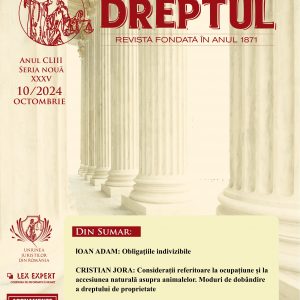
-
 The idea of recognizing nature’s legal capacity, with the consequence of attributing this entity of rights, began to be conveyed some time ago in the specialized literature. With all criticism, the theory has taken a certain shape and has even been included in the legislations, as is the case of Ecuador, which in 2008, by Constitution, Articles 71–74, recognized the law of nature, of the environment in general. Bolivia has adopted legal provisions, but not with constitutional power and, at the same time, has proposed a draft Universal Declaration of Nature Rights, which quickly gained adherence both at the level of states and in specialized literature with moderate optimism because it is stated that „we must be aware that the statement such as the one proposed cannot be expected to have immediate results”. The granting of rights to nature, as a new approach to the law of the environment that conceptualizes the natural, non-human world, as something worthy of protection for its own good, and not just as something that can be used for the benefit of the people, appeared in response to the failure of the model anthropocentric environment protection, also has its place in interesting processes.
The idea of recognizing nature’s legal capacity, with the consequence of attributing this entity of rights, began to be conveyed some time ago in the specialized literature. With all criticism, the theory has taken a certain shape and has even been included in the legislations, as is the case of Ecuador, which in 2008, by Constitution, Articles 71–74, recognized the law of nature, of the environment in general. Bolivia has adopted legal provisions, but not with constitutional power and, at the same time, has proposed a draft Universal Declaration of Nature Rights, which quickly gained adherence both at the level of states and in specialized literature with moderate optimism because it is stated that „we must be aware that the statement such as the one proposed cannot be expected to have immediate results”. The granting of rights to nature, as a new approach to the law of the environment that conceptualizes the natural, non-human world, as something worthy of protection for its own good, and not just as something that can be used for the benefit of the people, appeared in response to the failure of the model anthropocentric environment protection, also has its place in interesting processes. -
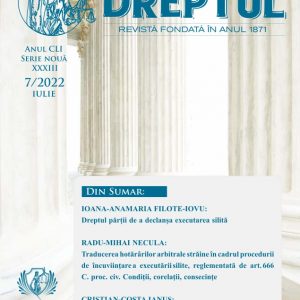 In a modern society, which faces many challenges, from the perspective of complying with the legal rules in force regarding the payment of taxes and duties owed to the state, in which the electronic means of payment and, mostly, the system of payments in virtual currencies, not very strictly regulated nowadays in any part of the world, it is necessary to take special legal measures to control and reduce socially dangerous deeds, such as tax evasion, money laundering, the appropriation by state officials of immeasurable assets, from doubtful sources, unverified or even illegal. The Romanian society has also not been exempt from such legislative and organizational concerns, especially since the specific challenges of an emerging and developing society and in correlation with good European practices have been much more pronounced. From this perspective, the Romanian legislator has designed an ingenious system of control and disclosure of assets acquired under conditions that exclude the justification of their sources of funding by the beneficiaries of these values, being integrated a legislative and administrative system for submission by the civil servants of some asset declarations and an organizational set for carrying out thorough verifications, by a specialized institution, called the National Integrity Agency (hereinafter referred to as ANI). However, in order for the ANI notifications not to unnecessarily burden the role of the courts of appeal in the country, by the Law No 115/1996 for the declaration and control of the assets of dignitaries, magistrates, of some persons with management and control positions and of civil servants, corroborated with the Law No 144/2007 on the establishment, organization and functioning of the National Integrity Agency and with the Law No 176/2010 on the integrity in exercising public functions and dignities, amending and supplementing the Law No 144/2007 on the establishment, organization and functioning of the National Integrity Agency, as well as amending and supplementing other normative acts, it was conceived an integrated institutional framework, through which ANI notifies the relevant cases from the perspective of unjustified assets to a specialized structure, integrated in the system of each court of appeal, called the commission of investigation of assets, which performs a preliminary verification of the evidence attached to the ANI notification and it can take the measure of notifying the court of law with this notification, if the origin of the assets acquired by the civil servant is unjustified, it may close the case, if the source is justified, or it may order the suspension of the control and the referral of the case to the competent prosecutor’s office. The present study intends to reveal the multiple valences of the acts of one of the most specialized institutions for verification and control of the assets of dignitaries and civil servants from Romania.
In a modern society, which faces many challenges, from the perspective of complying with the legal rules in force regarding the payment of taxes and duties owed to the state, in which the electronic means of payment and, mostly, the system of payments in virtual currencies, not very strictly regulated nowadays in any part of the world, it is necessary to take special legal measures to control and reduce socially dangerous deeds, such as tax evasion, money laundering, the appropriation by state officials of immeasurable assets, from doubtful sources, unverified or even illegal. The Romanian society has also not been exempt from such legislative and organizational concerns, especially since the specific challenges of an emerging and developing society and in correlation with good European practices have been much more pronounced. From this perspective, the Romanian legislator has designed an ingenious system of control and disclosure of assets acquired under conditions that exclude the justification of their sources of funding by the beneficiaries of these values, being integrated a legislative and administrative system for submission by the civil servants of some asset declarations and an organizational set for carrying out thorough verifications, by a specialized institution, called the National Integrity Agency (hereinafter referred to as ANI). However, in order for the ANI notifications not to unnecessarily burden the role of the courts of appeal in the country, by the Law No 115/1996 for the declaration and control of the assets of dignitaries, magistrates, of some persons with management and control positions and of civil servants, corroborated with the Law No 144/2007 on the establishment, organization and functioning of the National Integrity Agency and with the Law No 176/2010 on the integrity in exercising public functions and dignities, amending and supplementing the Law No 144/2007 on the establishment, organization and functioning of the National Integrity Agency, as well as amending and supplementing other normative acts, it was conceived an integrated institutional framework, through which ANI notifies the relevant cases from the perspective of unjustified assets to a specialized structure, integrated in the system of each court of appeal, called the commission of investigation of assets, which performs a preliminary verification of the evidence attached to the ANI notification and it can take the measure of notifying the court of law with this notification, if the origin of the assets acquired by the civil servant is unjustified, it may close the case, if the source is justified, or it may order the suspension of the control and the referral of the case to the competent prosecutor’s office. The present study intends to reveal the multiple valences of the acts of one of the most specialized institutions for verification and control of the assets of dignitaries and civil servants from Romania. -
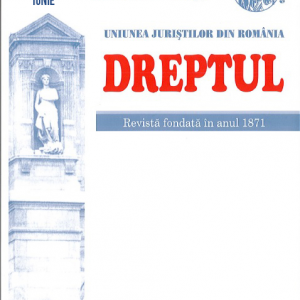 While authorities with jurisdiction in the management of European funds exercise control and investigative activities they issue documents which, although they enjoy the presumption of legality like any administrative act, may give rise to litigations. Based on the special normative acts relevant for the management of European funds and on Fiscal Procedure Code, this paper analyses documents issued by such authorities, their legal nature, as well as the procedure for contesting such documents, as a guarantee of the principle of free access to justice.
While authorities with jurisdiction in the management of European funds exercise control and investigative activities they issue documents which, although they enjoy the presumption of legality like any administrative act, may give rise to litigations. Based on the special normative acts relevant for the management of European funds and on Fiscal Procedure Code, this paper analyses documents issued by such authorities, their legal nature, as well as the procedure for contesting such documents, as a guarantee of the principle of free access to justice. -
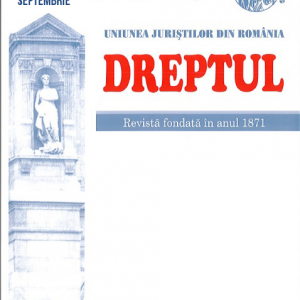 The action regulated by Article 1064 of the Civil Procedure Code has a special regime, derogating from the classic situation of tortious civil liability, regulated by Article 1357 of the Civil Code. The practical situation of this action is somewhat uncertain, as there is no unitary judicial practice that decides the legal nature of the action for damages provided by Article 1064 of the Civil Procedure Code. In these conditions, we considered it opportune to analyze the legal nature of the action for damages regulated by Article 1064 of the Civil Procedure Code, in a parallel vision with the provisions of Article 1357 of Civil Code, which regulates tortious civil liability. All this, by reference to those established by a recent court decision resolving such an action for damages. In the present study we tried to offer a perspective and a practical analysis on several situations generated by the application of Article 1064 of Civil Procedure Code.
The action regulated by Article 1064 of the Civil Procedure Code has a special regime, derogating from the classic situation of tortious civil liability, regulated by Article 1357 of the Civil Code. The practical situation of this action is somewhat uncertain, as there is no unitary judicial practice that decides the legal nature of the action for damages provided by Article 1064 of the Civil Procedure Code. In these conditions, we considered it opportune to analyze the legal nature of the action for damages regulated by Article 1064 of the Civil Procedure Code, in a parallel vision with the provisions of Article 1357 of Civil Code, which regulates tortious civil liability. All this, by reference to those established by a recent court decision resolving such an action for damages. In the present study we tried to offer a perspective and a practical analysis on several situations generated by the application of Article 1064 of Civil Procedure Code. -
 In this article, the author analyzes the legal nature of the parliamentary committees and concludes, together with other authors, that they should be considered as internal working bodies of each Legislative Chamber. The role of parliamentary committees, whether standing committees or committees of inquiry, or other special committees, is to prepare the works which are going to be debated in the plenum of the Legislative Assemblies. As working bodies, the parliamentary committees do not have their own decision-making power over the matter referred to them. In other words, the parliamentary committees do not express a political will, in a deliberative sense, because their role is to examine the matters referred to them by the standing bureaux of the Legislative Chambers and to make proposals thereto. The reports and opinions they make on the matters under examination have the value of recommendation made to the plenum of each Legislative Chamber, these being free – as deliberative bodies – to accept or reject the solutions proposed by the committees. Each Chamber of Parliament has the full freedom to set up specialized committees in certain areas of activity. The Constitution obliges the Legislative Chambers to set up permanent committees and to set up – when it deems necessary – committees of inquiry or other special committees. The composition of the parliamentary committees reflects, as far as possible, the political configuration of the Chamber that has decided to set them up.
In this article, the author analyzes the legal nature of the parliamentary committees and concludes, together with other authors, that they should be considered as internal working bodies of each Legislative Chamber. The role of parliamentary committees, whether standing committees or committees of inquiry, or other special committees, is to prepare the works which are going to be debated in the plenum of the Legislative Assemblies. As working bodies, the parliamentary committees do not have their own decision-making power over the matter referred to them. In other words, the parliamentary committees do not express a political will, in a deliberative sense, because their role is to examine the matters referred to them by the standing bureaux of the Legislative Chambers and to make proposals thereto. The reports and opinions they make on the matters under examination have the value of recommendation made to the plenum of each Legislative Chamber, these being free – as deliberative bodies – to accept or reject the solutions proposed by the committees. Each Chamber of Parliament has the full freedom to set up specialized committees in certain areas of activity. The Constitution obliges the Legislative Chambers to set up permanent committees and to set up – when it deems necessary – committees of inquiry or other special committees. The composition of the parliamentary committees reflects, as far as possible, the political configuration of the Chamber that has decided to set them up. -
 The study deals with the problem of the legal nature of the concurrence established between the offence of assault or other violences and the offence of ill-treatment of minor. The identity in material element between the two offences may be complete, in which case they are in formal concurrence. There is a complete identity in material element when both offences involve a duration of consumption in time. The identity in material element can not be complete, in which case the two offences are found in real concurrence. There is an incomplete identity in material element when the offence of ill-treatment of minor involves a duration of consumption in time, while the offence of assault or other violences lacks this feature.
The study deals with the problem of the legal nature of the concurrence established between the offence of assault or other violences and the offence of ill-treatment of minor. The identity in material element between the two offences may be complete, in which case they are in formal concurrence. There is a complete identity in material element when both offences involve a duration of consumption in time. The identity in material element can not be complete, in which case the two offences are found in real concurrence. There is an incomplete identity in material element when the offence of ill-treatment of minor involves a duration of consumption in time, while the offence of assault or other violences lacks this feature. -
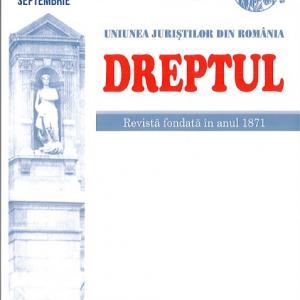 Unlike the previous legislation, which did not contain any reference to the progressive offence, the new Criminal Code indicates the time from which the prescription period starts to run for this type of offence, without regulating, however, other aspects referring to the criminal treatment applicable to the acts falling within the legal category in question. This task lays further on case-law and doctrine, but, having regard to the numerous contradictory solutions and controversies noted, some regulations to ensure a uniform settlement of the noticed aspects shall be required, de lege ferenda.
Unlike the previous legislation, which did not contain any reference to the progressive offence, the new Criminal Code indicates the time from which the prescription period starts to run for this type of offence, without regulating, however, other aspects referring to the criminal treatment applicable to the acts falling within the legal category in question. This task lays further on case-law and doctrine, but, having regard to the numerous contradictory solutions and controversies noted, some regulations to ensure a uniform settlement of the noticed aspects shall be required, de lege ferenda. -
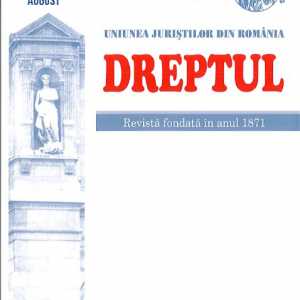 The study thus entitled draws the conclusion that the fiscal inspection report, as a deed preceding the issuance of the notice of assessment, cannot form the object of an action in the fiscal and administrative contentious neither severally nor jointly with the fiscal and administrative document, as erroneously resolved, in some occasions, by the Section of Administrative and Fiscal Contentious of the High Court of Cassation and Justice.
The study thus entitled draws the conclusion that the fiscal inspection report, as a deed preceding the issuance of the notice of assessment, cannot form the object of an action in the fiscal and administrative contentious neither severally nor jointly with the fiscal and administrative document, as erroneously resolved, in some occasions, by the Section of Administrative and Fiscal Contentious of the High Court of Cassation and Justice. -
 In this study, after a brief introduction on parental rights and obligations, the author examines, in the light of the legislation currently in force (Family Code – amended by Law no. 288/2007, and Laws no. 272/2004 and no. 273/ 2004), and in the light of the future Romanian Civil Code (published on July 24, 2009 but not yet into force), the status of parental rights and obligations, provided that the child has been legally entrusted to other persons, discussing, in this manner, with priority, the extent to which the parents are entitled to provide their consent to the marriage of their child (if the child is a minor) or to his/her adoption.
In this study, after a brief introduction on parental rights and obligations, the author examines, in the light of the legislation currently in force (Family Code – amended by Law no. 288/2007, and Laws no. 272/2004 and no. 273/ 2004), and in the light of the future Romanian Civil Code (published on July 24, 2009 but not yet into force), the status of parental rights and obligations, provided that the child has been legally entrusted to other persons, discussing, in this manner, with priority, the extent to which the parents are entitled to provide their consent to the marriage of their child (if the child is a minor) or to his/her adoption. -
 The very short term usucapion can be considered a specific simplified usucapion, regulated by the provisions of the Law No 7/1996, as amended and supplemented, which represents a special way of acquiring the property right with regard to the real estates, in principle, not registered in the land book and for which there are no property deeds, through the possession noted in the land book uninterrupted for a period of 3 years. The specific usucapion analyzed applies only for the acquisition of the property right, in case of sporadic registration operation, regarding real estate lands, with or without constructions, which may form the object of private property, not registered in the land book or registered in the land book opened under the Decree-law No 115/1938, in accordance with the law.
The very short term usucapion can be considered a specific simplified usucapion, regulated by the provisions of the Law No 7/1996, as amended and supplemented, which represents a special way of acquiring the property right with regard to the real estates, in principle, not registered in the land book and for which there are no property deeds, through the possession noted in the land book uninterrupted for a period of 3 years. The specific usucapion analyzed applies only for the acquisition of the property right, in case of sporadic registration operation, regarding real estate lands, with or without constructions, which may form the object of private property, not registered in the land book or registered in the land book opened under the Decree-law No 115/1938, in accordance with the law.
